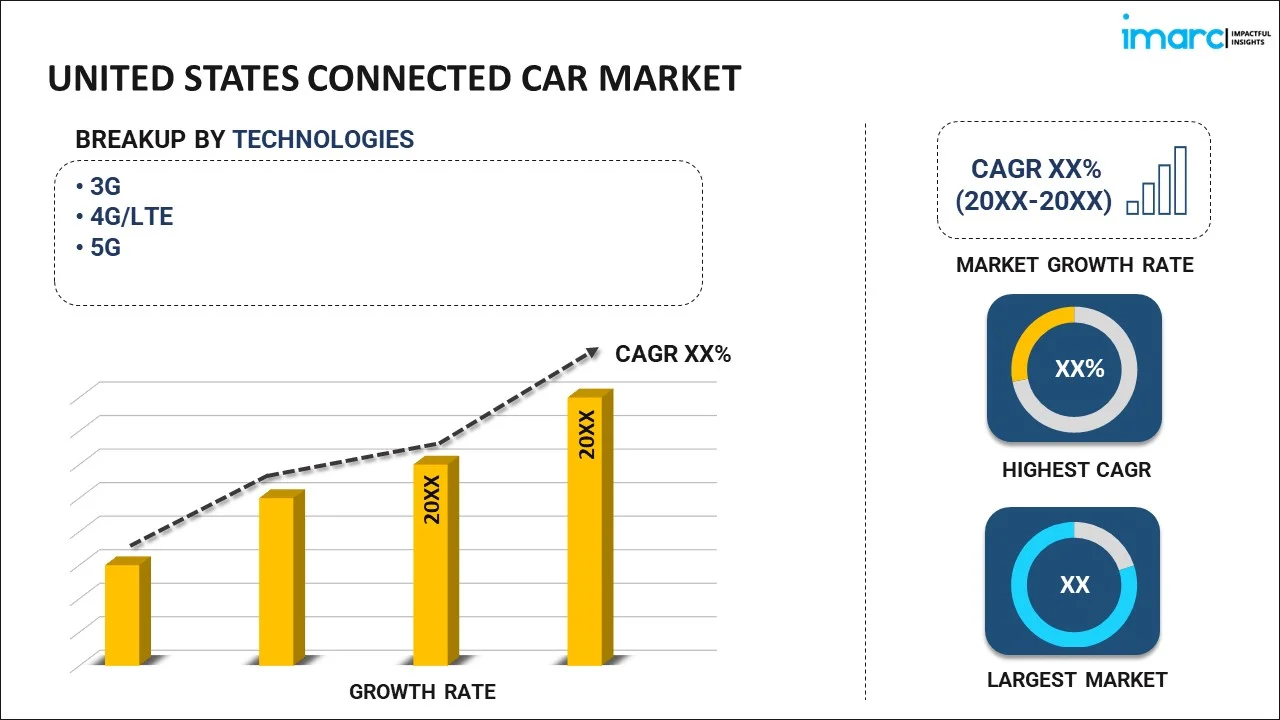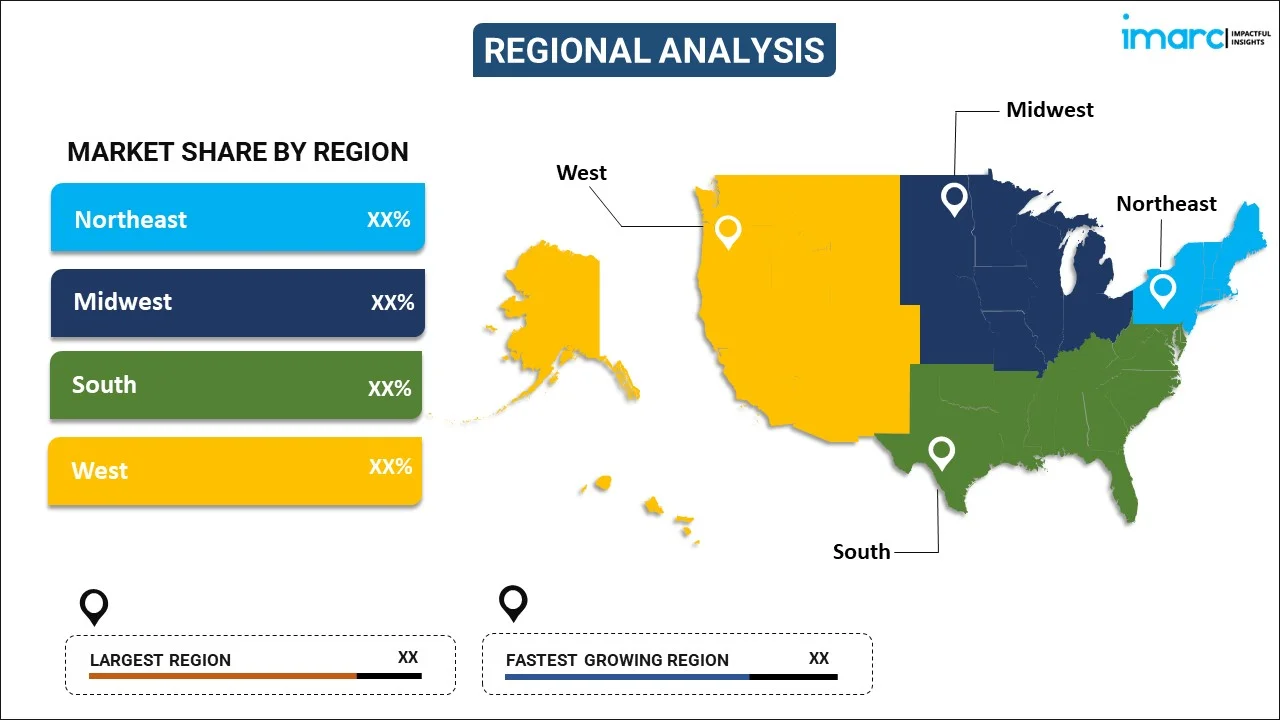
United States Connected Car Market Report by Technology (3G, 4G/LTE, 5G), Connectivity Solutions (Integrated, Embedded, Tethered), Service (Driver Assistance, Safety, Entertainment, Vehicle Management, Mobility Management, and Others), End Market (Original Equipment Manufacturer (OEMs), Aftermarket), and Region 2025-2033
Market Overview:
The United States connected car market size reached USD 23,743.2 Million in 2024. Looking forward, IMARC Group expects the market to reach USD 1,23,987.9 Million by 2033, exhibiting a growth rate (CAGR) of 20.16% during 2025-2033. The increasing consumer demand for connectivity features in vehicles, the implementation of several government regulations and initiatives for the safety of connected vehicles, and the emerging technological advancements such as the Internet of Things (IoT) represent some of the key factors driving the market.
|
Report Attribute
|
Key Statistics
|
|---|---|
|
Base Year
|
2024
|
|
Forecast Years
|
2025-2033
|
|
Historical Years
|
2019-2024
|
|
Market Size in 2024
|
USD 23,743.2 Million |
|
Market Forecast in 2033
|
USD 1,23,987.9 Million |
| Market Growth Rate 2025-2033 | 20.16% |
A connected car, also known as a smart or connected vehicle, is an automobile that is equipped with internet connectivity and several sensors and devices that allow it to collect and transmit data, which can be used for various purposes, including improving safety, enhancing the driving experience, and enabling advanced features and services. It is a part of the broader concept of the Internet of Things (IoT), where everyday objects are connected to the Internet to gather and exchange information. These vehicles are equipped with sensors that can monitor various aspects of the vehicle's performance and environment, which include a global positioning system (GPS) for location tracking, accelerometers for measuring speed and acceleration, and cameras for driver assistance and surveillance. It improves safety and can transmit real-time data about road conditions, traffic, and weather to drivers, helping them make informed decisions and avoid accidents. It can also provide automatic emergency assistance in the event of a collision, alerting emergency services and sharing crucial information about the incident. Additionally, connected cars offer convenience and enhanced functionality, allowing drivers to enjoy features including real-time traffic updates, navigation assistance, and remote vehicle diagnostics.
United States Connected Car Market Trends:
The market is primarily driven by the increasing consumer demand for connectivity features in their vehicles. Modern consumers are seeking a seamless and connected experience in their cars, mirroring the convenience and connectivity they enjoy in their daily lives through smartphones and other devices. In addition, connected cars offer several benefits, such as real-time navigation, vehicle diagnostics, and entertainment options, which enhance the overall driving experience, escalating the demand and enabling automakers to integrate advanced connectivity solutions into their vehicles, contributing to the market's growth. Moreover, the growing Internet of Things (IoT) and the expansion of the connected car market with the ability to connect vehicles to the Internet and other devices are opening up new possibilities for data collection and analysis, which can use various purposes, including predictive maintenance, vehicle safety, and enhanced driver assistance systems, representing another major growth-inducing factor. Besides this, the implementation of several government regulations and initiatives due to the potential safety benefits of connected vehicles, such as improved accident prevention and emergency response, is accelerating the market growth. As a result, there have been mandates and incentives to encourage the adoption of connected car technologies, which made it more attractive for automakers to invest in connectivity and increased consumer awareness and acceptance of these features. Furthermore, the increasing use of connected cars offers the promise of more efficient transportation systems by enabling vehicles to communicate with each other, and with infrastructure, such as traffic lights and road sensors, traffic management can be optimized, reducing congestion and emissions, thus creating positive market growth.
United States Connected Car Market Segmentation:
IMARC Group provides an analysis of the key trends in each segment of the market, along with forecasts at the country level for 2025-2033. Our report has categorized the market based on technology, connectivity solutions, service, and end market.
Technology Insights:

- 3G
- 4G/LTE
- 5G
The report has provided a detailed breakup and analysis of the market based on the technology. This includes 3G, 4G/LTE, and 5G.
Connectivity Solutions Insights:
- Integrated
- Embedded
- Tethered
A detailed breakup and analysis of the market based on the connectivity solutions have also been provided in the report. This includes integrated, embedded, and tethered.
Service Insights:
- Driver Assistance
- Safety
- Entertainment
- Vehicle Management
- Mobility Management
- Others
The report has provided a detailed breakup and analysis of the market based on the service. This includes driver assistance, safety, entertainment, vehicle management, mobility management, and others.
End Market Insights:
- Original Equipment Manufacturer (OEMs)
- Aftermarket
A detailed breakup and analysis of the market based on the end market have also been provided in the report. This includes original equipment manufacturer (OEMS) and aftermarket.
Regional Insights:

- Northeast
- Midwest
- South
- West
The report has also provided a comprehensive analysis of all the major regional markets, which include Northeast, Midwest, South, and West.
Competitive Landscape:
The market research report has also provided a comprehensive analysis of the competitive landscape. Competitive analysis such as market structure, key player positioning, top winning strategies, competitive dashboard, and company evaluation quadrant has been covered in the report. Also, detailed profiles of all major companies have been provided.
United States Connected Car Market Report Coverage:
| Report Features | Details |
|---|---|
| Base Year of the Analysis | 2024 |
| Historical Period | 2019-2024 |
| Forecast Period | 2025-2033 |
| Units | Million USD |
| Scope of the Report | Exploration of Historical Trends and Market Outlook, Industry Catalysts and Challenges, Segment-Wise Historical and Future Market Assessment:
|
| Technologies Covered | 3G, 4G/LTE, 5G |
| Connectivity Solutions Covered | Integrated, Embedded, Tethered |
| Services Covered | Driver Assistance, Safety, Entertainment, Vehicle Management, Mobility Management, Others |
| End Markets Covered | Original Equipment Manufacturer (OEMs), Aftermarket |
| Regions Covered | Northeast, Midwest, South, West |
| Customization Scope | 10% Free Customization |
| Post-Sale Analyst Support | 10-12 Weeks |
| Delivery Format | PDF and Excel through Email (We can also provide the editable version of the report in PPT/Word format on special request) |
Key Questions Answered in This Report:
- How has the United States connected car market performed so far and how will it perform in the coming years?
- What has been the impact of COVID-19 on the United States connected car market?
- What is the breakup of the United States connected car market on the basis of technology?
- What is the breakup of the United States connected car market on the basis of connectivity solutions?
- What is the breakup of the United States connected car market on the basis of service?
- What is the breakup of the United States connected car market on the basis of end market?
- What are the various stages in the value chain of the United States connected car market?
- What are the key driving factors and challenges in the United States connected car?
- What is the structure of the United States connected car market and who are the key players?
- What is the degree of competition in the United States connected car market?
Key Benefits for Stakeholders:
- IMARC’s industry report offers a comprehensive quantitative analysis of various market segments, historical and current market trends, market forecasts, and dynamics of the United States connected car market from 2019-2033.
- The research report provides the latest information on the market drivers, challenges, and opportunities in the United States connected car market.
- Porter's five forces analysis assist stakeholders in assessing the impact of new entrants, competitive rivalry, supplier power, buyer power, and the threat of substitution. It helps stakeholders to analyze the level of competition within the United States connected car industry and its attractiveness.
- Competitive landscape allows stakeholders to understand their competitive environment and provides an insight into the current positions of key players in the market.
Need more help?
- Speak to our experienced analysts for insights on the current market scenarios.
- Include additional segments and countries to customize the report as per your requirement.
- Gain an unparalleled competitive advantage in your domain by understanding how to utilize the report and positively impacting your operations and revenue.
- For further assistance, please connect with our analysts.

 Inquire Before Buying
Inquire Before Buying
 Speak to an Analyst
Speak to an Analyst
 Request Brochure
Request Brochure
 Request Customization
Request Customization



.webp)




.webp)












